The benefits of circular migration in Guatemala: A round-trip to the American dream
Around 9,000 Guatemalans traveled to the United States with temporary work contracts in one year, still a negligible number compared to the hundreds of thousands of those detained and deported for trying to cross the border irregularly
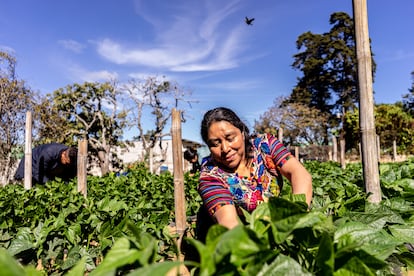
From his blackberry field, Arnoldo Chile looks at the Agua volcano with the peace of mind of someone who is exactly where he wants to be. He is 33 years old and has everything he has always dreamed of. He has his own land and a house that he shares with his wife in the village of El Rejón, near Sumpango, about one hour from Guatemala City. With an H-2A visa for agricultural workers in hand, Arnoldo has been back-and-forth to the United States since 2016. Every year, he spends eight months in California, where he works in the logistics of an agri-food company, and four months in Guatemala, where he takes care of the blackberry field he bought with his remittances.
In the village of Rancho Alegre, on the other side of Sumpango, Roselia Canel looks out the window of her room while embroidering a güipil. She thinks that she will soon have enough money to build a fashion workshop on the land she has just purchased. On the outskirts of the city, Juan Pacache and his wife are spreading fertilizer on their snow pea plantation, while, 15 kilometers away, in Santiago Sacatepéquez, Vilma Lemus is serving the last customers of the day at her fruit and vegetable stall.

The three worked as farmers in floriculture in South Dakota for a few months in 2023. “I earned around $4,000 a month. After four months of work, I saved enough to buy land and help my family with daily expenses,” explains Canel. The seamstress is convinced that if she manages to return to the United States three more times, she will be able to open her own embroidery business.
Chile, Pacache, Canel, and Lemus are some of the many Central Americans who are forced to emigrate to the United States for economic reasons, but among the few who have had the opportunity to do so on a regular basis.
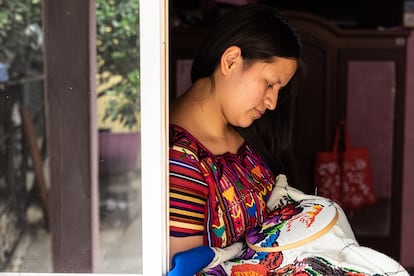
“Having a visa is a lifesaver because you are not forced to travel with human traffickers nor get yourself into debt,” Chile explains. “In only one year I was able to buy my first blackberry patch and create work to help develop my community,” the farmer says.
Chile and the others have these documents thanks to a program to send temporary agricultural workers from the Cuatro Pinos Cooperative. According to the United States Department of Homeland Security, around 9,000 people from Guatemala traveled to the United States with a temporary work contract in 2022. Of these, 2,982 arrived with the H-2A agricultural visa, and 5,999 came with the H-2B to temporary non-agricultural workers. All had been selected by private recruiters or through the Labor Mobility Program run by the Guatemalan Ministry of Labor.
I earned around $4,000 dollars a month. After four months of work, I had saved enough to buy a piece of land and help my family with daily expenses.Roselia Canel, migrante guatemalteca
Despite the increase in temporary regular visas, the trend still contrasts with the 55,302 Guatemalans deported from the United States by air, the 19,665 from Mexico by land, and the 222,085 detained in the attempt to irregularly cross into the United States in 2023 alone. A coyote on average charges an irregular migrant $7,500 for the transfer from Guatemala to the United States. Human trafficking is the predominant means of traveling to North America for a Guatemalan forced to move due persecution, criminality, or lack of employment.
Processing a temporary work visa can take up to 120 days and getting one is not easy. It all starts when employers in the United States ask the U.S. Department of Labor for a labor certification that demonstrates the need to hire temporary foreign workers due to the lack of a local workforce. The employer then makes a request for non-migrant workers and, if no local workers apply for the position, the selection process abroad begins, often with the support of companies or recruiting bodies.
One of them is Cierto Global, whose director Johana Bustamante explains that they select qualified labor through agricultural workers’ organizations in Guatemala. “We conduct interviews and evaluate skills like strawberry picking or pea cutting. Once the company has selected the workers, we begin the visa process,” he clarifies.
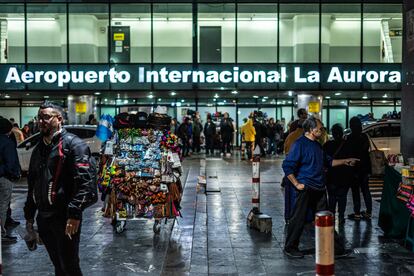
There is no limit on the number of H2-A visas that can be granted. The H2-B has a cap of 66,000, expanded in 2024 by an additional 64,716 visas aimed mainly at people with previous experience with US companies. This makes it difficult for workers to be accepted by their first placement.
Furthermore, to date, the United States has mainly welcomed temporary Mexican workers, to whom the United States granted 91% of these visas in 2022. In turn, this reduces hiring opportunities for Guatemalans and other Central Americans.
“Temporary regular migration from Guatemala to the United States is new and at the moment there are only a few contracts with Guatemalan companies,” Bustamente continues. “On top of that, processing the visas takes a long time and not many people here trust this kind of migration due to the scams perpetrated by false recruiters who promise work contracts in exchange for money.”
Coyote scams
Vilma Lemus was a victim of the trafficking scammers.“In 2008, my sister and I heard about a man who sent farmers to the United States in exchange for 10,000 quetzales (almost $1,300) per visa,” she says looking away sadly. She sold the only land she had to raise the money, but the coyote disappeared. She lost everything. “For many years I thought about not leaving, then I met Cierto Global and once again I put my faith in the being able to travel to the United States as a regular migrant,” she adds.
In March 2023, Lemus went to plant flowers for an American company for a season. She only had to pay 400 quetzales (about $50) for the passport. Her airfare, visa, and accommodation were provided by the employer, which is normal in agricultural worker recruitments. Upon returning home, Lemus managed to pay off accumulated debts and help support her three children, a niece, and her octogenarian mother. “There were times when we didn’t even eat. But thanks to the money I earned abroad, I was able to cover basic expenses and rented a store where I sell fruit, vegetables, and traditional costumes,” says Lemus.
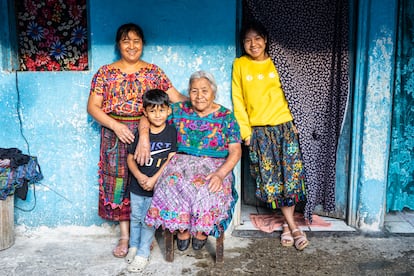
Among the recruiters recognized by Guatemala’s Ministry of Labor is the Cuatro Pinos Agricultural Cooperative. Since 2016 it has implemented a regular migration program exclusively for members’ families. Vanessa García, the head of social responsibility at Cuatro Pinos, emphasizes that in the last year they sent 150 workers, who sent a combined total of $1.5 million in remittances, which was invested in production in Guatemala. “Temporary migration allows workers not to put their lives at risk along the way. They do not have to pay the debt to the coyote and they manage to maintain family ties because they return in a few months,” she says.
Temporary migration allows them not to put their lives at risk along the way. They do not have to pay the debt to the coyote and they manage to maintain family ties because they return in a few monthsVanessa García, encargada de responsabilidad social de la Cooperativa agrícola Cuatro Pinos
An irregular migrant usually lives abroad for an average of 13.6 years before returning home, with the risk of losing family and community ties. The uprooting that these migrants suffer contrasts with the experience of Juan Pacache, who has lived with circular migration for two decades, first to Canada and now to the United States, without losing the bond with his family.
“My house and my snow pea crop are the fruit of my remittances,” says Pacache. He boasts that after his first trip, he invested in his children’s education. “Now all my savings are used to buy land, fertilizers, seeds, and to hire people to work with me.” His aim is to reinvest the money to also benefit those who did not have the opportunity to travel.
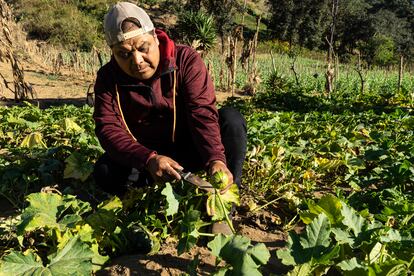
Sending remittances to Guatemala increased by 11.5% in the first eight months of 2023 compared to the previous year, representing almost 19% of GDP. According to the Action Against Hunger report titled Temporary regular migration to Canada and the United States, both regular and irregular migrants send remittances, but regular migrants do so more frequently, with higher monthly amounts. They also return home with greater savings and work experience which they can put to good use.
In general, women are a minority in temporary agricultural employment programs. American employers prefer male labor and often lack separate, women-only housing. “I feel lucky that I was chosen last year,” Canel says. Considering that they have proven that they can work “at the same pace or faster” than men. “They should give us more opportunities to travel, especially because traveling with a coyote is very dangerous for us,” says Canel.
While Canel awaits approval for her visa to travel to the United States again, Lemus and Pacache returned to South Dakota in March of this year, where they will stay for a few months. They work hard all week. At night they call their families and talk about their day. Although they sometimes feel homesick, the idea of returning soon and improving life in their home country keeps them motivated. Pacache believes that the Guatemalan authorities should consider that people want to work abroad. “They have to facilitate the hiring process in Canada and the United States, allowing those who decide to migrate to do so on a regular basis. We want to live here, in this country that we are building with our remittances, and we ask that our rights as migrant workers be respected,” he concludes.
Sign up for our weekly newsletter to get more English-language news coverage from EL PAÍS USA Edition
Tu suscripción se está usando en otro dispositivo
¿Quieres añadir otro usuario a tu suscripción?
Si continúas leyendo en este dispositivo, no se podrá leer en el otro.
FlechaTu suscripción se está usando en otro dispositivo y solo puedes acceder a EL PAÍS desde un dispositivo a la vez.
Si quieres compartir tu cuenta, cambia tu suscripción a la modalidad Premium, así podrás añadir otro usuario. Cada uno accederá con su propia cuenta de email, lo que os permitirá personalizar vuestra experiencia en EL PAÍS.
¿Tienes una suscripción de empresa? Accede aquí para contratar más cuentas.
En el caso de no saber quién está usando tu cuenta, te recomendamos cambiar tu contraseña aquí.
Si decides continuar compartiendo tu cuenta, este mensaje se mostrará en tu dispositivo y en el de la otra persona que está usando tu cuenta de forma indefinida, afectando a tu experiencia de lectura. Puedes consultar aquí los términos y condiciones de la suscripción digital.
More information
Archived In
Últimas noticias
There is as much life left to discover on planet Earth as that which is already known
Dozens presumed dead, around 100 injured in fire at Swiss Alps bar during New Year’s celebration
Is porn for women different from conventional porn? We spoke to those who make it
Cartagena de Indias is sinking: What can the city do to mitigate it?
Most viewed
- Sinaloa Cartel war is taking its toll on Los Chapitos
- Reinhard Genzel, Nobel laureate in physics: ‘One-minute videos will never give you the truth’
- David King, chemist: ‘There are scientists studying how to cool the planet; nobody should stop these experiments from happening’
- Oona Chaplin: ‘I told James Cameron that I was living in a treehouse and starting a permaculture project with a friend’
- The Interoceanic Train, the Mexican alternative to the Panama Canal










































